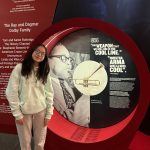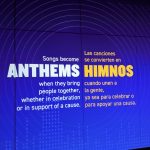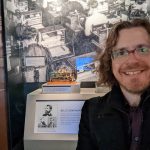By Professor Tiffany Banks On Tuesday, September 30th , students from my COMM 108: Foundations…
by Professor Ted Shusterman
On Sunday, November 3, 2024, I visited two Smithsonian museums along with my two sections of MUSC-131 American Popular Music. Both sections are in the Dual Enrollment program at Montgomery College, with one section in the Middle College program and the other in the Early College program. There are 50 students between the two sections, and approximately 35 were able to attend on this day, with the others attending on a different day.
We visited both the National Museum of African American History and Culture (NMAAHC), as well as the National Museum of American History (NMAH), in preparation for a Digital Story assignment.
Students were encouraged to visit at least two of the following exhibits:
NMAAHC Musical Crossroads (including the interactives Neighborhood Record Store and In the Studio)
NMAH Entertainment Nation (including America’s Listening)
NMAH Music HerStory
The goal was to explore the displays and experience music history, and, in the process, to find an object, artifact, person, song, or any combination of items that spoke to them, or to an issue on a larger scale that they may also be able to relate to. Students were asked to consider: how does the item connect to or relate to a relevant issue/topic to them, their family, or their community, to society, and or the world?
The students were prepared with a number of Harvard’s Project Zero’s Thinking Routines to help them examine and uncover both the stories buried within the museum’s displays, as well as the students’ own stories in relation to the artifacts.
The day of the visit was full of excitement. Students were provided a time to meet at the NMAAHC, and I met them there. Along the way, I started encountering students on the Metro, then again while walking from the Metro station to the NMAAHC more students were arriving. By the time we arrived, it was now a group experience.
The first stop was Musical Crossroads. I had planned to take a group picture at 10:30am in front of the Parliament Funkadelic Mothership, but half of the students disappeared five minutes before the photo. “Where’d everyone go?” The resulting photo is about 1/3 of the students who came to the museum that day – not counting the family and friends who joined them.
The Mothership proved to be popular with students, as was Chuck Berry’s Cadillac and his guitar “Maybellene”:





I found a number of students were drawn to the interactive In The Studio, where, working in pairs as a Recording Engineer and Mixing Engineer, participants could remix a song in real time – but only if they worked together. This activity helped to highlight some of the issues and challenges, as well as enjoyment and fulfillment, experienced by record producers and engineers. I saw some students get frustrated, but others persevered and got to hear the results of their work.

Many students explored the exhibit in pairs and in small groups, and were on their own to explore freely, while I was on hand to answer any questions if needed.


After wrapping up at the NMAAHC, we traveled across the street to the NMAH.

Upon entering the NMAH, I pointed out one of my favorite items on display: Herbie Hancock’s Keytar that was used on his 1983 performances of “Rockit”. I’m a big fan and had just seen Mr. Hancock perform in DC a few weeks prior, still jumping around on stage with his keytar.

Many students began their tour of the NMAH in Entertainment Nation. Students were enthralled by the sights and sounds of American popular culture. Two of the more popular displays were Prince’s Cloud Guitar and Selena’s Leather Outfit.




And of course, there’s the picture of me posing with the guitar in the March 27, 2024 SFF Blog Post of our cohort’s visit to NMAH.


Also popular were the interactives “What’s Your Anthem?” and the recordings of early recording media on display in America’s Listening. Both of these are favorites of mine as well.
“What’s Your Anthem” contains a piece of the stage from the Woodstock Music and Arts Festival of 1969 – and you can stand on it while viewing the various anthems.


Early recording technology is a passion of mine, and the original phonographs, cylinders, and gramophones on display make me marvel at how far we’ve come in sound reproduction.


Unfortunately, many early recording media have been lost to time or physical degradation. Fortunately, the Library of Congress has been working with the SI to digitally restore and preserve historical recordings for future generations through Project Irene and the exhibition Hear My Voice (currently online only) with some of the audio samples listenable through the interactive display in America’s Listening..
In Music HerStory the displays on Jean Richie, Willie Mae “Big Mama” Thornton, Peggy Seeger, and the Girl Power Movement of the 1990s resonated with those who explored them.
 Many students reflected on their visit to the museums and the connection to both American and music history and culture, as they saw firsthand, artifacts and objects that represented not only the music and the people we’ve covered in class, but how it’s all connected.
Many students reflected on their visit to the museums and the connection to both American and music history and culture, as they saw firsthand, artifacts and objects that represented not only the music and the people we’ve covered in class, but how it’s all connected.
Student quotes:
“Being able to personally connect with history for a class project was really fun and made me want to do it. The flexibility around the museum times and the different exhibits we could use for the project was really helpful in completing the project.”
“Being able to see how things have evolved from back in the day till now is fascinating. Also being able to experience this with friends was very enjoyable.”
“I really enjoyed seeing artifacts that belonged to the same people I learned about in class.”
“I loved how I was able to see the history of many iconic songs and learn the history of the music industry.”
“In the African American Museum of History and Culture, the part about producing where you could make a song and the Entertainment Nation exhibit were fun.”
“I think the trip was fun. It allowed me to think of music in a different way. It also helped with my researching and ultimately video-making skills (because of the project). I hadn’t gone to a museum for a project in prior to this trip so this was my first time, but I enjoyed it.”
“My museum visit helps me learn and create a better connection with the music cultural, including how the music impacts the society of the world.”
“I enjoyed being exposed to different sections in the museums. Because of walking around and trying to find the specified sections we had to visit, I saw plenty other sections which caught my eye. I went with my mother and we had a lot of fun exploring a few of those sections on our own after seeing the required ones.”
“I got to learn while spending time with my family
 ]
]





This Post Has 0 Comments